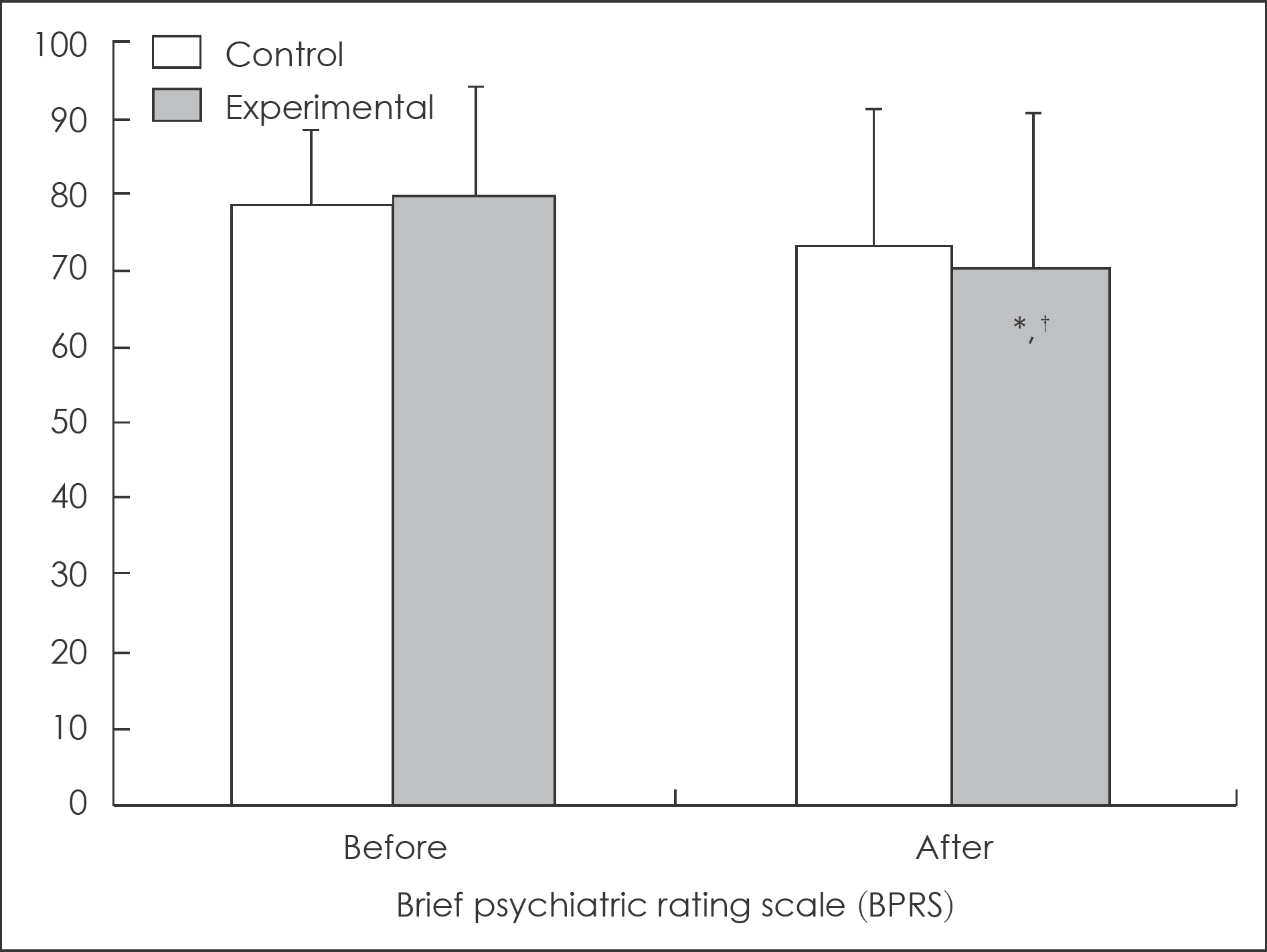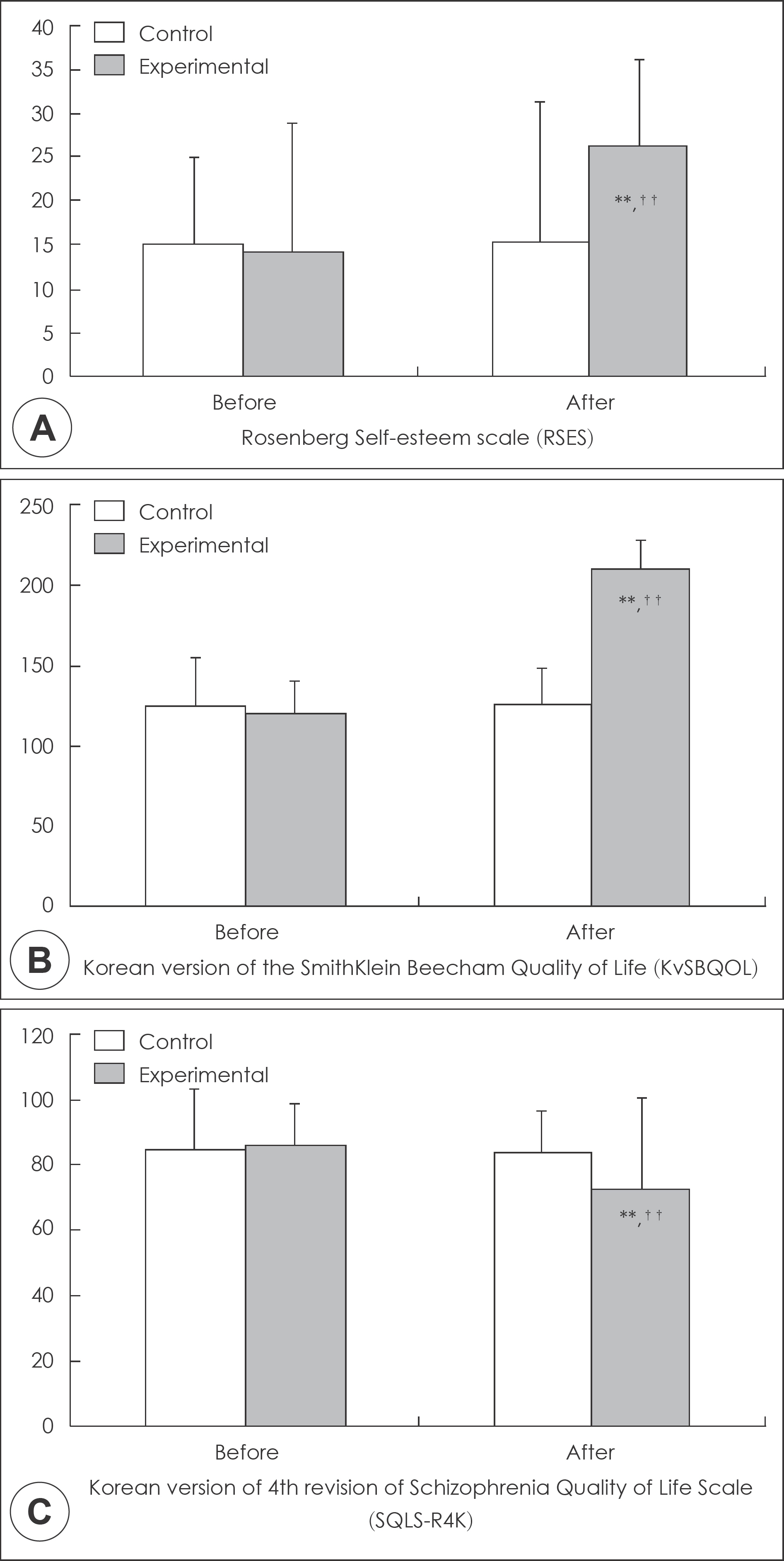Korean J Schizophr Res.
2012 Jun;15(1):20-26. 10.16946/kjsr.2012.15.1.20.
The Effect of a 12-week Weight Management Program on the Quality of Life in Patients with Schizophrenia
- Affiliations
-
- 1Department of Psychiatry, Bongseng Memorial Hospital, Busan, Korea. my-pilsoon@hanmail.net
- KMID: 1790743
- DOI: http://doi.org/10.16946/kjsr.2012.15.1.20
Abstract
OBJECTIVES
This study was designed to examine the effect of a 12-week weight management program on the quality of life, self-esteem and psychotic symptoms of schizophrenia.
METHODS
The subjects of the experiment consisted of psychiatric patients taking antipsychotics who were diagnosed with DSM-IV schizophrenia. The experimental group were patients with body mass index of 25 kg/m2 or above who participated in a 12-week weight management program, while the control group did not join the program. All the patients were admitted in closed psychiatry ward of a mental hospital. The program consisted of diet therapy, exercise, behavior modification and education. All the patients were checked on Brief Psychiatric Rating Scale (BPRS), Rosenberg Self-esteem Scale (RSES), Korean version of the SmithKlein Beecham Quality of Life (KvSBQOL), Korean version of 4th revision of Schizophrenia Quality of Life Scale (SQLS-R4K) and the weight.
RESULTS
After the 12-week weight management program, RSES, KvSBQOL and SQLS-R4K were increased significantly in the experimental group (p<0.001), as opposed to the control group. While the experimental group showed a notable increase in body weight and body mass index (BMI), the change in the control group was insignificant. BPRS was decreased significantly (p<0.05).
CONCLUSION
12-week weight management program had a positive effect to decrease the weight and to increase the self-esteem and quality of life. This study provides evidence for the potential and beneficial effect of weight management program for schizophrenic patients.
Keyword
MeSH Terms
Figure
Reference
-
References
1). Allison DB, Mentore JL, Heo M, Chandler LP, Cappelleri JC, Infante MC, et al. Antipsychotic-induced weight gain: A comprehensive research synthesis. Am J Psychiatry. 1999; 156:1686–1696.2). Ryan MC, Thakore JH. Physical consequences of schizophrenia and its treatment: The metabolic syndrome. Life Sci. 2002; 71:239–257.3). Zimmermann U, kraus T, Himmerich H, Schuld A, Pollmächer T. Epidemiology, implications and mechanisms underlying drug-induced weight gain in psychiatric patients. J Psychiatr Res. 2003; 37:193–220.
Article4). Baptista T, Kin NM, Beaulieu S. Treatment of the metabolic disturbances caused by antipsychotic drugs: Focus on potential drug interactions. Clin Pharmacokinet. 2004; 43:1–15.5). Melkersson K, Dahl ML. Adverse metabolic effects associated with atypical antipsychotics: Literature review and clinical implications. Drugs. 2004; 64:701–723.6). Hoebel BG, Hernandez L, Mark GP. Brain microdialysis as a molecular approach to obesity serotonin dopamine cychc-AMP. In. Obesity towards a molecular approach Ed by Bray GA, Ricquier D, Spiegelman BM. New York: Wiley-Liss;1989. p. 45–62.7). Parada MA, Hernandez L, Hoebel BG. Sulpiride injections in the lateral hypothalamus induce feeding and drinking in rats. Pharmacol Biochem Behav. 1988; 30:917–923.
Article8). Alter GA, Boyar WC, Oei E, Wood PL. Cholecystokinin attenuates basal and drug-induced increases of limbic and striatal dopamine release. Brain Res. 1988; 460:76–82.9). Baptista T, LaCruz A, Hernandez L. Glucose tolerance and serum insulin levels in an animal model of obesity induced by the antipsychotic drug sulpride. Pharmacol Toxicol. 1998; 83:57–61.10). Ravussin E. Metabolic differences and the development of obesity. Metabolism. 1995; 44:12–14.
Article11). Gerardo-Gottens T, Moore BJ, Stern JS, Horwitz BA. Prolactin stimulates food intake in a dose-dependent manner. Am J Physiol. 1989; 256:276–280.12). Ferreira NF, Sobrinho LG, Pires JS, Silva MES, Santos MA, Santos MFF. Endocrine and psychological evaluation of women with recent weight gain. Psychoneuroendocrinology. 1995; 20:53–63.
Article13). Baptista T, Lacruz A, Meza T. Prevalence of obesity in outpatients receiving antipsychotic drugs correlation with serum prolactine levels. Caracas, Venezuela Regional Symposium of the World Federation of Societies of Biological Psychiatry Catacas, Venezuela. Venezuelan Psychiatric Association Press;1998. p. 17.14). Foss MC, Paula FJ, Paccola GM, Piccinato CE. Pheripheral glucose metabolism in human hyperprolactinemia. Chn Endocrinol. 1995; 43:721–726.15). Homel P, Casey D, Allison DB. Changes in body mass index for individuals with and without schizophrenia, 1987–1996. Schizophr Res. 2002; 55:277–284.
Article16). Foreyt J, Goodrick K. The ultimate trumph of obesity. Lancet. 1995; 346:34–35.17). Perkins DO. Adherence to antipsychotic medications. J Clin Psychiatry. 1999; 60(suppl 21):25–30.18). Faulkner G, Cohn TA. Pharmacologic and nonpharmacologic strategies for weight gain and metabolic disturbance in patients treated with antipsychotic medications. Can J Psychiatry. 2006; 51:502–511.
Article19). Faulkner G, Soundy AA, Lloyd K. Schizophrenia and weight management: a systematic review of interventions to control weight. Acta Psychiatr Scand. 2003; 108:324–332.
Article20). Werneke U, Taylor D, Sanders TA, Wessely S. Behavioral management of antipsychotic-induced weight gain: a review. Acta Psychiatr Scand. 2003; 108:252–259.21). Evans S, Newton R, Higgins S. Nutritional intervention to prevent weight gain in patients commenced on olanzapine: a randomized controlled trial. Aust N Z J Psychiatry. 2005; 39:479–486.
Article22). Brown C, Goetz J, Van Sciver A, Sullivan D, Hamera E. A psychiatric rehabilitation approach to weight loss. Psychiatr Rehabil J. 2006; 29:267–273.
Article23). Dunbar GC, Stoker MJ, Hodges TCP, Beaumont G. The development of SBQOL – A unique scale for measuring quality of life. Brit J Med Econo. 1992; 2:65–74.24). World Health Organization. WHOQOL Study Protocol. WHO;(MNH/PSF/93.9).Geneva: WHO;1993.25). Yoon JS, Kook SH, Lee MS. A preliminary study on Korean Version of the SmithKlein Beecham Quality of Life Scale (KvSBQOL). J Korean Neuropsychiatr Assoc. 1998; 37(2):280–294.26). Hunt SM, McKenna SP. Measuring quality of life in psychiatry. Quality of Life Assessment: Key Issue in the 1990s. Ed by. Walker SR and Rosser RM, editor. London: Kluwer Academic Publishers;1993. p. 343–354.
Article27). Norman RM, Malla AK, McLean T, Voruganti LP, Cortese L, McIntosh E, et al. The relationship of symptoms and level of functioning in schizophrenia to general wellbeing and the quality of Life Scale. Acta Psychiatr Scand. 2000; 102:303–309.
Article28). Meltzer HY. Outcome in schizophrenia: beyond symptom reduction. J Clin Psychiatry. 1999; 60:32–35.29). Cramer JA, Rosenhack R, Xu W, Thomas J, Henderson W, Chamey DS. Quality of life in schizophrenia: a comparison of instruments. Department of Veterana Affairs Cooperative Study Group on Clozapine in refractory schizophrenia. Schizophr Bull. 2000; 26:659–666.30). Breier A, Berg PH, Thakore JH, Naber D, Gattaz WF, Cavazzoni P, et al. Olanzapine versus ziprasidone: result of a 28-week double-blind study in patients with schizophrenia. Am J Psychiatry. 2005; 162:1879–1887.31). Overall JE, Gorham DR. The brief psychiatric rating scale. Psychol Rep. 1962; 10:799–812.
Article32). Rosenberg M. Society and Adolescent self-image. Princeton NJ: Princeton University Prese;1965.33). Dunbar GC, Stocker NJ, Hodges TCP, Beaumont G. The development of SBQOL – A unique scale for measuring quality of life. Brit J Med Econo. 1992; 2:65–74.34). Stoker MJ, Dunbar GC, Beaumont G. The SmithKlein Beecham ‘quality of life'scale: A validation and reliability study inpatients with affective disorder. Qual Life Res. 1992; 1:385–395.35). Kim JH, Yim SJ, Min SK, Kim SE, Son SJ, Park SH, et al. The Korean version of 4th revision of Schizophrenia Quality of Life Scale: validation study and relationship with PANSS. J Korean Neuropsychiatr Assoc. 2006; 45:401–410.36). Wilkinson G, Hesdon B, Wild D, Cookson R, Farina C, Sharma V, et al. Self-report quality of life measure for people with schizophrenia: the SQLS. Br J Psychiatry. 2000; 177:42–26.
Article37). lean ME. Sibutramine a review of clinical efficacy. Int J Obes Relat Metab Disord. 1997; 21:30–36.38). Goodall E, Oxtoby C, Richards R, Watkinson G, Brown D, Silverstone T. A clinical trial on the efficacy and acceptability of D-fenfluramine in the treatment of neuroleptic-induced obesity. Br J Psychiatry. 1988; 153:209–213.
- Full Text Links
- Actions
-
Cited
- CITED
-
- Close
- Share
- Similar articles
-
- The Effect of Weight Reduction on the Obesity-Related Quality of Life, Physical and Emotional Well-Being in Obese Schizophrenic Inpatients
- The Effects of Insight and Empowerment on Function and Quality of Life for Patients with Schizophrenia
- Effects on Stress, Problem Solving Ability and Quality of Life of as a Stress Management Program for Hospitalized Schizophrenic Patients: Based on the Stress, Appraisal-Coping Model of Lazarus & Folkman
- Subjective Quality of Life in Patients with Schizophrenia Receiving Antipsychotics: Relationship among Subjective Quality of Life, Drug Attitude, and Side-effect Profiles of Drugs
- A New Goal of Treatment for Schizophrenia: Quality of Life




